Guitar
Roughly four years ago, I acquired a much abused Gibson SG Junior and set about repairing some fairly brutal body routing prior to refinishing it in Pelham Blue. After a few misteps in the refinishing process - I set the project aside. Meanwhile, I sold my house and moved the Guitar Garage to a new location in an old textile mill in Waltham MA and the poor old SG just sat leaning up against a wall.
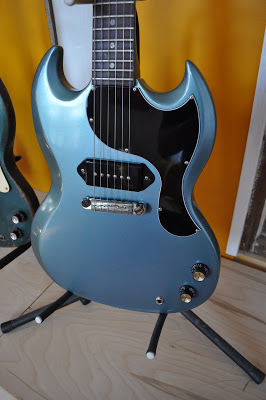
This past winter I decided it was finally time to attack this project again and finish it up.
The initial steps in the repair of the body are documented in a prior post which you can read here. After doweling and epoxying in a block of mahogany - I used my router to cut a nice clean surface on the back where I could glue in a 1/4 thick pieces of mahogany to get a level smooth surface on the back.
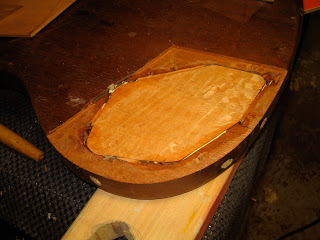
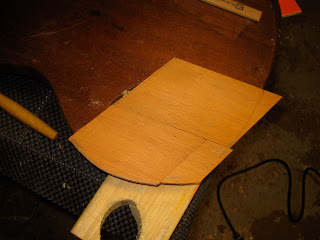
On the front, the glued in block was actually pretty smooth so I just used some epoxy to fill some gaps and glued in a piece of mahogany where the pickup cavity had been over-routed.
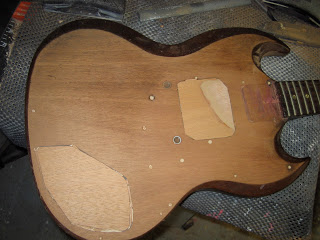
Once the body was blocked up, I had to re-rout it for the correct control cavity and pickup cavity - as well as dowel and epoxy the oversized tuner holes in the headstock. I made a series of masonite templates to guide the routing of the control cavity and pickup cavity - tracing from an original Junior to get the correct shape and orientation.
I routed out the pickup cavity first - and you can see that some of the original "floor" and cherry finish was still present.
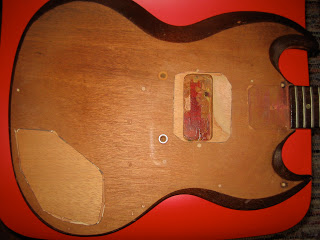
I traced the location of the control cavity routing ( I actually only had a tracing of the cover and cover location but used pictures I found online to define the cavity shape).

Here's the control cavity routed along with the repro plastic cover I fabricated.
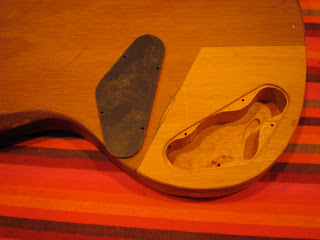
With the repro pickguard in place.
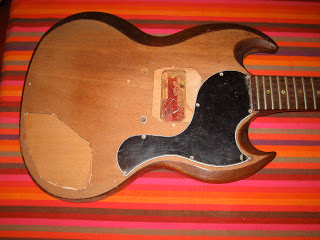
Note the serial number 282371 - which places this guitar as an early 1965 production instrument. This guitar has some attributes that differentiate it from later SG Juniors - most notably the fairly fat neck which is also wider at the nut than later years. The 1963 through 1965 SG Juniors also had a smaller control cavity than later Juniors - which had the standard full size routing that was common to SG Juniors, SG Specials, SG Standard, EB-0 and EB-3 basses and Firebirds. I believe the transition to the larger control cavity happened in late 1965.

Despite the ridiculous routing to the body - this guitar had never suffered a headstock crack nor a heel crack - and had not been routed out for a neck position pickup, so the longer neck tenon was intact.
Once all the woodwork was done - I started using the standard procedure for finishing a mahogany guitar - which means filling the grain, sanding, then spraying several layers of sanding sealer and then sanding again until the grain is completely filled. I have detailed this process in other posts, so I didn't document it here.
Here's the body getting an initial coat of Pelham Blue - note that there is no primer coat, as Gibson didn't use primers for their custom color instruments.

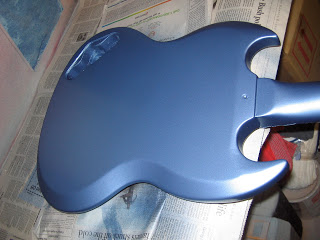
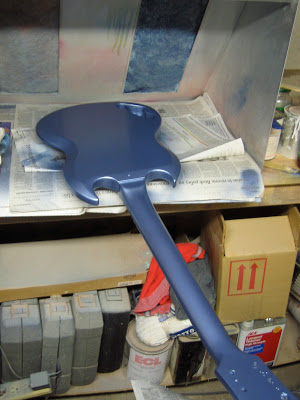
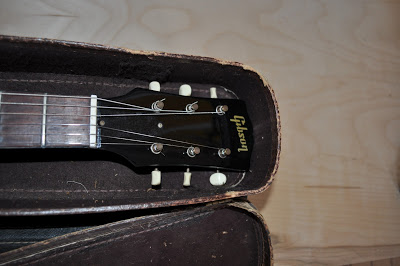
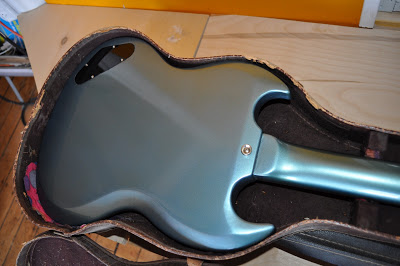


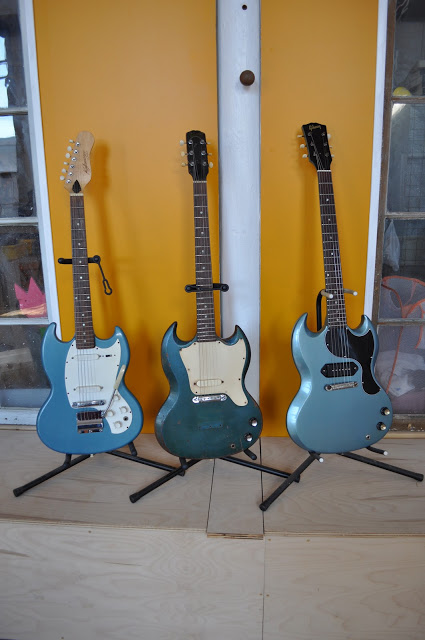
- 1965 Fender Jazzmaster, Candy Apple Red Restoration
My buddy Rod brought this guitar to me a few years ago - he had purchased it because it was almost entirely original - with the exception of the factory Candy Apple Red finish, which was stripped off. The original finish remained in the pickup...
- 1966 Fender Jazzmaster: Aged Olympic White
< A fairly straightforward project here - a 1966 Fender Jazzmaster body that had been poorly refinished over the years and that the owner wanted to do in an aged Olympic White finish. The original Olympic White is a color thats seldom seen - its a bright...
- Radical Ibanez Roadstar Bassmod, In Daphne Blue
Here's a project I just started a few days ago - for a client from the local "Bassment" forum. This started out as an Ibanez Roadstar 2 Bass - presumably from the 80s. As you can see from a picture of the bass before any mods, it was a fairly conventional...
- 1971 Fender Precision Bass Refinish In Sonic Blue !!!
Another Fender Precision Bass project - an older maple board P-bass that has been through some changes, namely, the body has the classic added Jazz bass pickup at the bridge route, plus a route to sink a BadAss 1 bridge into the top and of course, a route...
- Squier Strat Quickie Paint Job
A customer acquired Squier of indeterminate vintage, for free I believe, and decided they wanted to "spiff" it up without spending a lot. Since the Squier had the typical poly urethane/polyester bowling ball finish and it was a heavy plywood body, we...
Guitar
1965 Gibson SG Junior, Pelham Blue: Completed Finally !!
Roughly four years ago, I acquired a much abused Gibson SG Junior and set about repairing some fairly brutal body routing prior to refinishing it in Pelham Blue. After a few misteps in the refinishing process - I set the project aside. Meanwhile, I sold my house and moved the Guitar Garage to a new location in an old textile mill in Waltham MA and the poor old SG just sat leaning up against a wall.

This past winter I decided it was finally time to attack this project again and finish it up.
The initial steps in the repair of the body are documented in a prior post which you can read here. After doweling and epoxying in a block of mahogany - I used my router to cut a nice clean surface on the back where I could glue in a 1/4 thick pieces of mahogany to get a level smooth surface on the back.
On the front, the glued in block was actually pretty smooth so I just used some epoxy to fill some gaps and glued in a piece of mahogany where the pickup cavity had been over-routed.
Once the body was blocked up, I had to re-rout it for the correct control cavity and pickup cavity - as well as dowel and epoxy the oversized tuner holes in the headstock. I made a series of masonite templates to guide the routing of the control cavity and pickup cavity - tracing from an original Junior to get the correct shape and orientation.
I routed out the pickup cavity first - and you can see that some of the original "floor" and cherry finish was still present.
I traced the location of the control cavity routing ( I actually only had a tracing of the cover and cover location but used pictures I found online to define the cavity shape).
Here's the control cavity routed along with the repro plastic cover I fabricated.
With the repro pickguard in place.
Note the serial number 282371 - which places this guitar as an early 1965 production instrument. This guitar has some attributes that differentiate it from later SG Juniors - most notably the fairly fat neck which is also wider at the nut than later years. The 1963 through 1965 SG Juniors also had a smaller control cavity than later Juniors - which had the standard full size routing that was common to SG Juniors, SG Specials, SG Standard, EB-0 and EB-3 basses and Firebirds. I believe the transition to the larger control cavity happened in late 1965.
Despite the ridiculous routing to the body - this guitar had never suffered a headstock crack nor a heel crack - and had not been routed out for a neck position pickup, so the longer neck tenon was intact.
Once all the woodwork was done - I started using the standard procedure for finishing a mahogany guitar - which means filling the grain, sanding, then spraying several layers of sanding sealer and then sanding again until the grain is completely filled. I have detailed this process in other posts, so I didn't document it here.
Here's the body getting an initial coat of Pelham Blue - note that there is no primer coat, as Gibson didn't use primers for their custom color instruments.
After this step - I applied a tinted clear coat to the body and neck - which gave it more of an "aqua" color - a strong green tint. I liked the color, but I ended up having some clear coat pool at the bottom of the heel joint - which just did not look right. As I was getting very busy with other work, I put the project aside.
After revisiting the guitar a few months later - I could see that the color coat had fully cured - and shrunk - and now not only was the mahogany grain visible in places, but so were some of the seams from the fill blocks. In frustration, I put the project aside once again.
Fast forward 3 years later - and I'm in my new shop - and I decide its time to just "get 'er done" as Larry the Cableguy would say ...
I ended up using an oribtal sander with 320 grit to sand down the front and back of the body - and then a block to do the edges and neck - finishing up with a lot of hand sanding. In some places I went through to the clear sealer coats, in some there was still some yellowed topcoat visible - but I made sure that everything was completely level before spraying several more clear coats on the entire instrument followed by careful wet sanding.
I also finally sprayed the headstock face black and applied a repro decal and numerous clear coats to hide the decal film.
At this point I felt pretty certain that the mahogany was extremely well sealed and that the routing repairs were as invisible as they were going to get.
I applied two thin coats of Pelham Blue lacquer (from TCP Global) - and then immediately clear coated the finish. In my experience its NOT possible to sand a metallic color coat at all - you have to lay down a nice even color and finish - using lots of thinner and maybe a touch of 3M's "Smoothie" - and then rely on the clear topcoat for achieving the real glossy finish.
After a few days - I then carefully applied a tinted clear coat - which was clear gloss lacquer primarily tinted with Stew-Mac's "Vintage Amber" dye, with a small amount of "Brown" and "Cherry" added to so that the lacquer had the color of dark honey in the paint cup. I focused on getting an nice even tint- slowly building it up with a wider spray pattern. The tinted coat was followed with three coats of clear gloss lacquer - and then I let the finish cure for a week and a half before wet sanding and buffing it out.
The final product is pictured below - it has the original wrap-around "lightning bolt" bridge, some mid-60s Kluson tuners, repro knobs and pots and currently has a GFS P-90 pickup, though I may switch in a '64 Gibson P-90 once I find a cover that fits it correctly.

The guitar had not been strung up in 4 years, but the neck settled in place perfectly and the guitar plays great - and is easy on the neck at a mere 5 lbs, 12 ozs !! (compare that to my concrete bass !)
The SG Junior is pictured here alongside some contemporary "brethren": a 1967 Kalamazoo KG-2 (by Gibson) in its version of Pelham Blue; a 1966 Gibson Melodymaker in very very aged Pelham Blue; and the 1965 SG Junior.

- 1965 Fender Jazzmaster, Candy Apple Red Restoration
My buddy Rod brought this guitar to me a few years ago - he had purchased it because it was almost entirely original - with the exception of the factory Candy Apple Red finish, which was stripped off. The original finish remained in the pickup...
- 1966 Fender Jazzmaster: Aged Olympic White
< A fairly straightforward project here - a 1966 Fender Jazzmaster body that had been poorly refinished over the years and that the owner wanted to do in an aged Olympic White finish. The original Olympic White is a color thats seldom seen - its a bright...
- Radical Ibanez Roadstar Bassmod, In Daphne Blue
Here's a project I just started a few days ago - for a client from the local "Bassment" forum. This started out as an Ibanez Roadstar 2 Bass - presumably from the 80s. As you can see from a picture of the bass before any mods, it was a fairly conventional...
- 1971 Fender Precision Bass Refinish In Sonic Blue !!!
Another Fender Precision Bass project - an older maple board P-bass that has been through some changes, namely, the body has the classic added Jazz bass pickup at the bridge route, plus a route to sink a BadAss 1 bridge into the top and of course, a route...
- Squier Strat Quickie Paint Job
A customer acquired Squier of indeterminate vintage, for free I believe, and decided they wanted to "spiff" it up without spending a lot. Since the Squier had the typical poly urethane/polyester bowling ball finish and it was a heavy plywood body, we...
